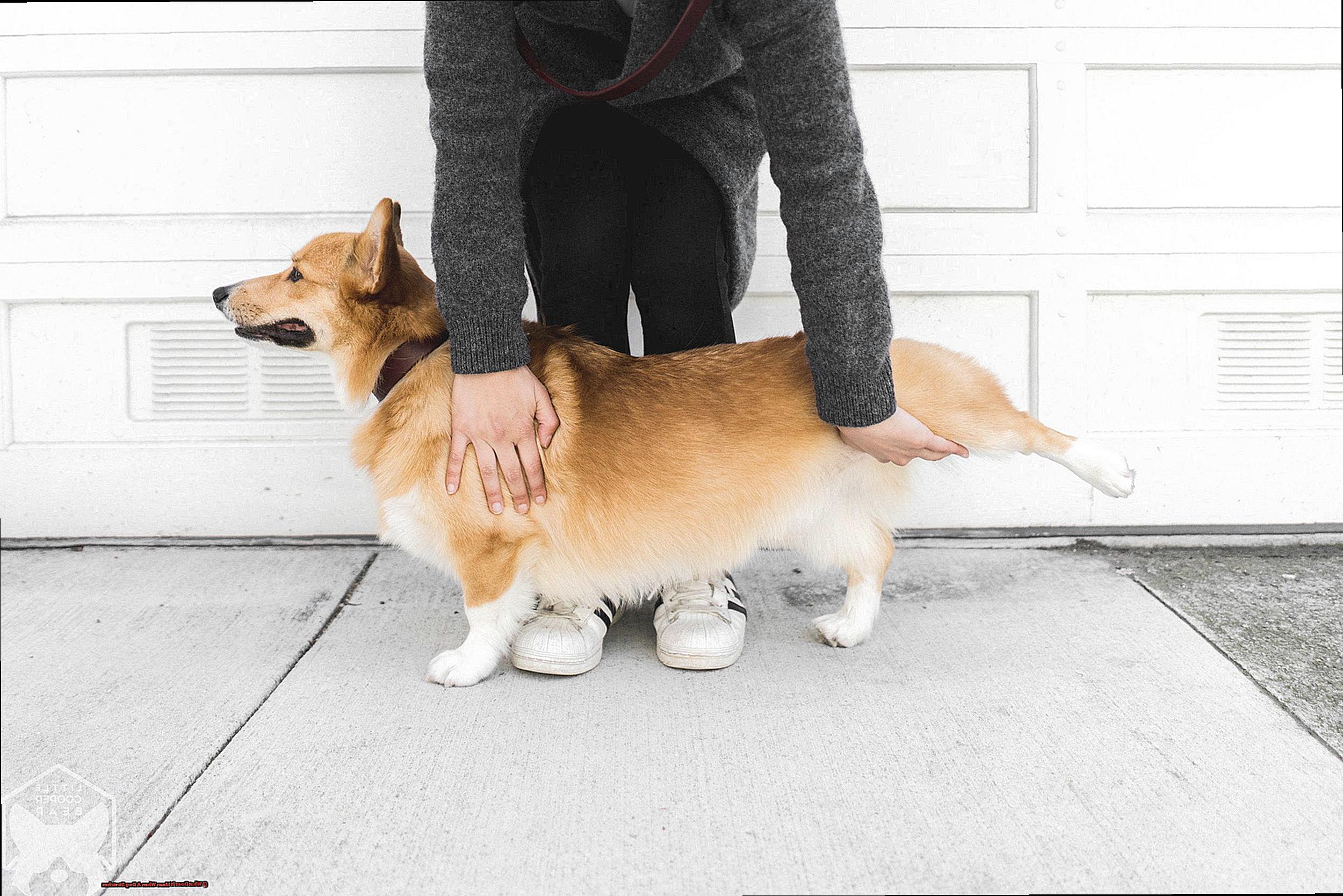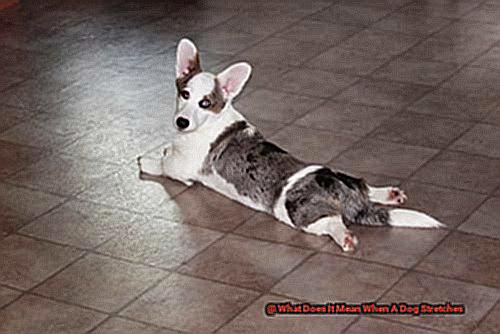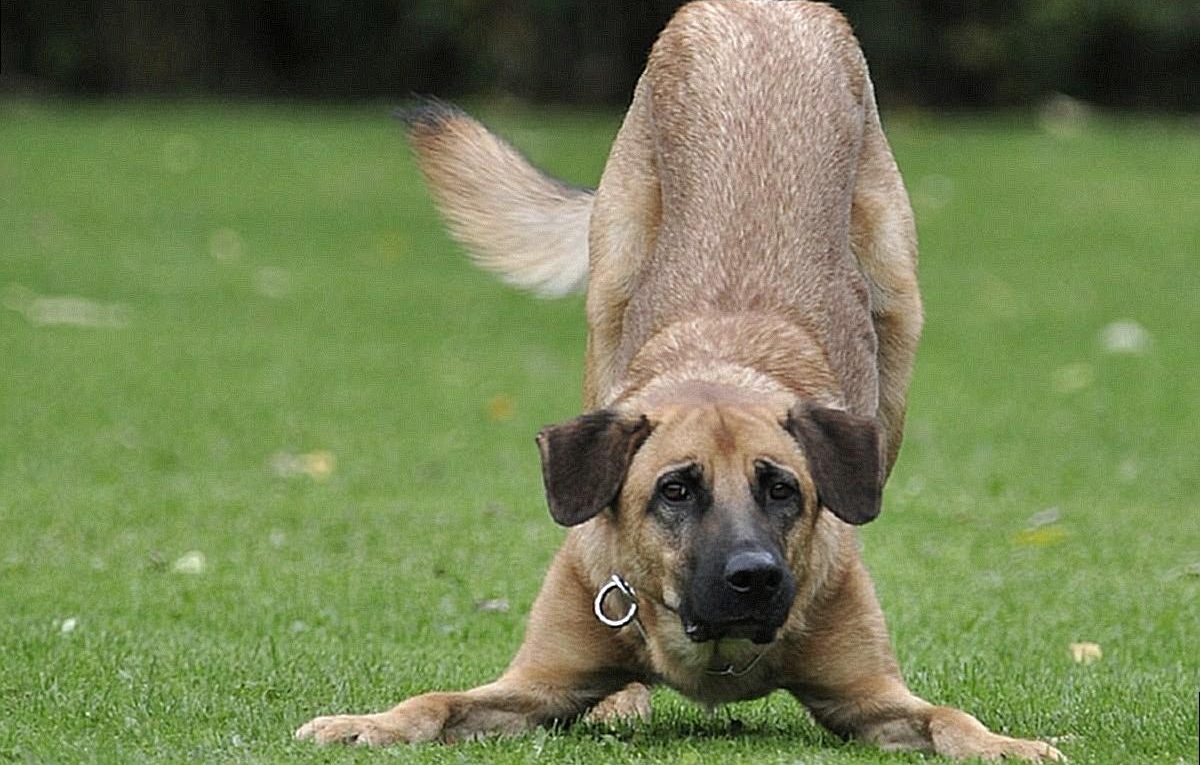What Does It Mean When A Dog Stretches?
From their playful antics to their unwavering loyalty, they never fail to bring a smile to our faces. But have you ever noticed your pup stretching?
It may seem like a simple movement, but there’s more to it than meets the eye. In fact, stretching is an essential part of a dog’s daily routine and can reveal a lot about their physical and mental state.
Get ready to learn something new about your furry best friend.
What Does It Mean When A Dog Stretches?
Contents
- 1 What Does It Mean When A Dog Stretches?
- 2 Understanding Your Dog’s Stretching Habits
- 3 Reasons Why Dogs Stretch
- 3.1 Why do dogs stretch?
- 3.2 Additionally, dogs may stretch as a way to communicate with their owners. When a dog stretches in front of you or near you, it could be a sign that they are seeking attention or wanting to play. It can also be a way for them to mark their territory and leave behind their scent through their paws and glands.
- 3.3 How to safely stretch with your French Bulldog
- 4 How to Safely Incorporate Stretching into Your Dog’s Routine
- 5 Different Types of Stretches for Dogs
- 6 Common Issues That Can Affect a Dog’s Ability to Stretch
- 7 Tips for Helping Your French Bulldog Stretch Properly
- 8 Conclusion
As a proud French Bulldog owner, you may have noticed your furry friend’s adorable stretchy behavior. But have you ever wondered why they do it? Or if it’s beneficial for them? As a self-proclaimed expert on all things dogs, I’m here to answer those questions and provide some insights into the world of dog stretching.
Why Do Dogs Stretch?
Just like us humans, dogs stretch for a variety of reasons. Some of the most common reasons include:
- Warming Up: Just like athletes before a big game, dogs often stretch before physical activity. It helps to increase blood flow and oxygen to their muscles, preparing them for playtime or walks.
- Relieving Tension: Dogs can experience tightness and soreness in their muscles from everyday activities like sleeping in awkward positions or being inactive for too long. Stretching helps to alleviate this tension and promote healing.
- Stress Relief: You may have noticed your dog stretching after a stressful event, such as a thunderstorm or a visit to the vet. This is because stretching can be a form of self-soothing and help to release tension and anxiety.
Physical and Mental Benefits of Stretching for Dogs
Stretching not only feels good for dogs, but it also has many physical and mental benefits that can improve their overall well-being. Some of these benefits include:
- Improved Flexibility: Just like with humans, regular stretching can improve your dog’s flexibility and range of motion. This is especially important for breeds like French Bulldogs, who are prone to joint issues.
- Better Circulation: Stretching helps to increase blood flow and oxygen to the muscles, promoting healing and reducing the risk of injury.
- Stress Relief: As mentioned before, stretching can be a way for dogs to release tension and calm themselves during stressful situations.
Tips for Encouraging Proper Stretching Habits in French Bulldogs
As a French Bulldog owner, you know that these adorable pups are known for their playful and active nature. To ensure they stay healthy and happy, it’s essential to encourage proper stretching habits. Here are some tips to help:
Incorporate Stretching into Playtime: Make stretching a part of your dog’s playtime routine. Encourage them to stretch before and after playing to warm up and cool down their muscles.
Understanding Your Dog’s Stretching Habits
As a French bulldog owner, you may have noticed your furry friend’s adorable stretching habits. You may have even caught yourself mimicking their stretches as they melt your heart with their cuteness. But have you ever wondered why your French bulldog stretches so frequently? And why it is important for you, as an owner, to understand their stretching behavior? In this post, we will dive into the reasons behind your French bulldog’s stretching habits and why it matters for their overall well-being.
Stretching is a natural behavior for dogs, just like it is for humans. It helps them relieve tension in their muscles and maintain flexibility. Dogs are active animals, and stretching helps them prepare for physical activities like running and playing. It also aids in preventing injuries by keeping their muscles and joints limber.
But stretching is not only beneficial for your dog’s physical health; it can also indicate their comfort and relaxation levels. Just like how we stretch when we wake up or after sitting for a long time, dogs also stretch to release tension in their bodies. So, if you see your French bulldog stretching after a nap or lounging on the couch, it’s a good sign that they are feeling content and relaxed.
While all dogs stretch, different breeds may have unique stretching routines and preferences. This can be due to their physical traits or even breed-specific behaviors. For instance, French bulldogs have a stocky build and short limbs, which can impact their stretching habits. They may have shorter stretches compared to other breeds and prefer to stretch on flat surfaces rather than reaching up high.
As a responsible owner, it is crucial to observe your dog’s stretching patterns and take note of any changes or abnormalities. If you notice your French bulldog is not stretching as much as they used to or has difficulty stretching certain body parts, it could be a sign of an underlying issue. In such cases, it is recommended to consult with a veterinarian to address any concerns and ensure your furry friend’s well-being.
Moreover, understanding your dog’s individual needs and preferences when it comes to stretching can enhance your bond with them. Some French bulldogs may prefer stretching after waking up, while others may do so before or after meals. By paying attention to their habits and catering to their preferences, you can help them maintain a healthy and happy lifestyle.
Reasons Why Dogs Stretch
As a French Bulldog owner, you may have noticed your furry friend doing some stretches throughout the day. Whether it’s after waking up from a nap or before playing, stretching is a natural behavior for dogs that serves many purposes. As an expert on this topic, let’s dive deeper into why dogs stretch and how to safely incorporate stretching into your French Bulldog’s routine.
Why do dogs stretch?
Just like humans, dogs need to stretch to maintain their flexibility and range of motion. Stretching helps to keep their muscles and joints healthy, preventing stiffness and promoting blood flow. It also plays a crucial role in preventing injury, as it helps to warm up the muscles before physical activity.
Additionally, dogs may stretch as a way to communicate with their owners. When a dog stretches in front of you or near you, it could be a sign that they are seeking attention or wanting to play. It can also be a way for them to mark their territory and leave behind their scent through their paws and glands.
How to safely stretch with your French Bulldog
- Observe your dog’s stretching habits: Every dog is unique, and so are their stretching preferences. Some dogs may prefer gentle stretches that focus on their neck, back, and hind legs, while others may enjoy more intense stretches that require a lot of flexibility. Pay attention to your French Bulldog’s body language and adjust accordingly.
- Start slow: Just like humans, dogs need to warm up before stretching. Before going for a walk or playing, take a few minutes to walk around with your dog to get their muscles warmed up.
- Use treats as motivation: While some dogs may naturally enjoy stretching, others may need some motivation. Use treats as positive reinforcement when introducing new stretches to your French Bulldog.
- Avoid overstretching: While stretching is essential, it’s crucial not to overdo it. Be mindful of your dog’s limits and avoid forcing them into stretches that may cause discomfort or pain.
- Consult with a professional: If you have any concerns about your French Bulldog’s stretching behavior, consult with your veterinarian or a professional dog trainer. They can provide personalized recommendations based on your dog’s breed, age, and overall health.
How to Safely Incorporate Stretching into Your Dog’s Routine
Whether it’s after waking up from a nap or before going on a walk, dogs naturally stretch to keep their muscles and joints flexible. Just like humans, stretching is an essential part of a dog’s routine to maintain their physical health and well-being. But as with any physical activity, there are certain precautions that need to be taken to ensure your dog’s safety. In this guide, we will explore how to safely incorporate stretching into your dog’s routine to help them stay healthy and happy.
Start Slow and Gradually Increase Intensity:
Just like humans, dogs need to warm up their muscles before engaging in any physical activity. This is especially important for French Bulldogs, who are prone to joint issues. Before incorporating stretching into your dog’s routine, start with shorter stretches and gradually increase the intensity and duration as your dog becomes more comfortable. This will help prevent any strains or injuries.
Pay Attention to Body Language:
While stretching is a natural behavior for dogs, it’s essential to pay attention to your French Bulldog’s body language during the process. If they seem uncomfortable or in pain, stop immediately and consult with your veterinarian. Some signs of discomfort may include whining, panting excessively, or trying to pull away from the stretch. As an expert on this topic, I recommend observing your dog’s body language and stopping if you notice any signs of distress.
Avoid Forcing Stretches:
It’s important to remember that stretching should never be forced on a dog. If your French Bulldog shows resistance or discomfort during a stretch, do not continue. Forcing a stretch can lead to injuries and cause your dog to become reluctant to stretch in the future. Instead, use positive reinforcement techniques such as treats and praise to make stretching a fun and rewarding experience for your dog.
Seek Guidance from Professionals:
If you are unsure about how to safely incorporate stretching into your dog’s routine, consider seeking guidance from a professional dog trainer or physical therapist. They can provide personalized advice on safe and effective stretching techniques for your specific breed and age of dog. This is especially important if your French Bulldog has any pre-existing health conditions or injuries.
Make Stretching Fun:
Just like any other activity, dogs are more likely to participate in stretching if it is fun and enjoyable. Use treats and positive reinforcement to make stretching a positive experience for your dog. Additionally, staying consistent with a routine and keeping the sessions short and engaging will help encourage your French Bulldog to continue stretching regularly.
Different Types of Stretches for Dogs
If you’re a French Bulldog owner, you probably know that these adorable and quirky pups have their own unique way of doing things. From their snorting and snoring to their playful and loving personalities, Frenchies are one-of-a-kind dogs that bring joy and laughter into our lives. But did you know that they also have their own special way of stretching?
Just like humans, dogs need to stretch to stay limber and prevent stiffness and soreness. However, the way they stretch can tell us a lot about how they are feeling physically and emotionally. As an expert on this topic, I’m here to guide you through the different types of stretches that French Bulldogs commonly do and what they may be trying to communicate through these stretches.
The Play Bow
The “play bow” is a classic stretch that Frenchies (and most other dog breeds) do when they want to play. You may have seen your Frenchie lower their front legs to the ground while keeping their hind end up in the air, with their tail wagging excitedly. This stretch is an invitation for other dogs or humans to join in on the fun.
Tip: If your Frenchie does a play bow but seems hesitant or unsure, it could be a sign of fear or aggression instead of playfulness.
Be observant of your dog’s body language and make sure all playtime is safe and enjoyable for everyone involved.
The Full-Body Stretch
After a long nap or period of rest, you may notice your Frenchie doing a full-body stretch, extending their front and back legs out behind them while arching their back. This stretch helps to loosen up their muscles and get the blood flowing again after being inactive for a while.
Tip: Encourage your Frenchie to stretch regularly, especially before and after physical activity.
This can help prevent injuries and keep their muscles and joints healthy.
The “Yoga-Like” Stretch
Similar to the downward-facing dog pose in yoga, some dogs (including Frenchies) do a stretch where they extend their front legs out in front of them while keeping their hind legs extended behind them and their head towards the ground. This stretch can indicate that your Frenchie is feeling tense or anxious and is trying to release some tension.
Tip: If your Frenchie is displaying this type of stretch frequently, it may be a sign of underlying anxiety or stress.
Consult with your veterinarian if you have any concerns.
Common Issues That Can Affect a Dog’s Ability to Stretch
As pet owners, we all want our furry friends to live happy and healthy lives. Just like us, dogs need regular exercise and proper care to maintain their physical well-being. One essential aspect of their health is stretching. Stretching is not only crucial for maintaining flexibility and mobility in dogs but also has many other benefits. In this blog post, we will discuss the importance of stretching for French Bulldogs, common issues that can affect a dog’s ability to stretch, and how to overcome them.
The Importance of Stretching for French Bulldogs
Stretching is a vital part of a dog’s physical health. It helps maintain their range of motion, prevents injuries, and improves circulation. For French Bulldogs, who are prone to joint problems, stretching is even more critical. As they have a stocky and muscular build, these dogs need regular stretching to keep their muscles and joints limber and prevent stiffness.
Moreover, stretching also promotes mental well-being in dogs. Just like humans, dogs can hold tension in their muscles when they are anxious or stressed. Regular stretching exercises can help them release this tension, leading to a more relaxed and content state of mind.
Common Issues That Can Affect a Dog’s Ability to Stretch

Unfortunately, there are some common issues that can affect a dog’s ability to stretch. These include physical ailments, obesity, lack of exercise, age, anxiety/stress, and genetic conditions.
- Physical Ailments: Dogs may have trouble stretching due to physical ailments such as arthritis, muscle strains, or injuries. These can limit their range of motion and make it uncomfortable or painful for them to stretch.
- Obesity: Extra weight puts added pressure on a dog’s joints and muscles, making it challenging for them to move and stretch comfortably.
- Lack of Exercise: A sedentary lifestyle can also lead to stiffness in dogs, making it difficult for them to stretch and maintain flexibility. This is especially true for breeds like French Bulldogs, who are prone to joint problems.
- Age: As dogs get older, their muscles and joints may become weaker, making stretching more challenging. It’s essential for owners of senior dogs to encourage gentle stretching exercises to help maintain their mobility.
- Anxiety/Stress: Dogs can hold tension in their muscles when they are anxious or stressed, making it harder for them to relax and stretch.
Tips for Helping Your French Bulldog Stretch Properly
As a French Bulldog owner, you may have noticed your dog’s unique stretching habits. These compact and muscular pups may have a tougher time stretching than other breeds, but it’s just as important for them to maintain flexibility and prevent injuries. As an expert on French Bulldogs, I’m here to share with you the importance of proper stretching for your furry friend and some practical tips to help them stretch effectively.
Why is Stretching Important for French Bulldogs?

Just like humans, dogs stretch to relieve tension and tightness in their muscles. This is especially important for breeds like French Bulldogs, who are prone to joint and muscle problems due to their stocky build. Stretching helps to increase blood flow and oxygen circulation, which can improve muscle function and flexibility. It also prepares them for physical activity, preventing injuries during playtime or walks.
In addition to physical benefits, stretching can also help alleviate anxiety and stress in dogs. Dogs may stretch as a way to release tension and calm themselves, similar to how we might take a deep breath or do some yoga poses when feeling overwhelmed. This is especially helpful for rescue dogs or those with anxiety issues.
Tips for Helping Your French Bulldog Stretch Properly
Start with Gentle Massages
Before attempting any stretches, gently massage your dog’s muscles to warm them up. This will help loosen any tightness or knots and make them more pliable for stretching.
Use Treats or Toys
Make stretching a fun and positive experience for your dog by using treats or toys to encourage them. This will also help reinforce positive behavior.
Focus on Major Muscle Groups
When stretching your French Bulldog, focus on the major muscle groups such as the legs, neck, and back. These are the areas that tend to get the most tight and can benefit from stretching.
Hold Stretches for 10-15 Seconds
It’s important to hold each stretch for at least 10-15 seconds, then release slowly. This will give your dog’s muscles time to relax and improve their flexibility.
Be Consistent
Consistency is key when it comes to helping your French Bulldog stretch properly. Make it a part of their daily routine, and they will thank you for it.
Pay Attention to Your Dog’s Body Language
It’s crucial to listen to your dog’s body language while stretching. If they seem uncomfortable or in pain, stop immediately and try a different stretch or consult with your veterinarian.
Don’t Overdo it
Just like humans, dogs can overstretch and cause muscle strain or tears. It’s recommended to stretch your French Bulldog 2-3 times a day, with each session lasting no more than 10 minutes.
Also Read: Can French Bulldogs Fly On Delta
Conclusion
In conclusion, the action of a dog stretching can have various meanings and interpretations.
It can be a sign of physical discomfort or relaxation, as well as a way to communicate with their owners. It is important for dog owners to pay attention to their pet’s body language and overall well-being in order to properly interpret their stretches.
So next time you see your furry friend stretching, take a moment to appreciate the complexity and significance behind this seemingly simple action.




